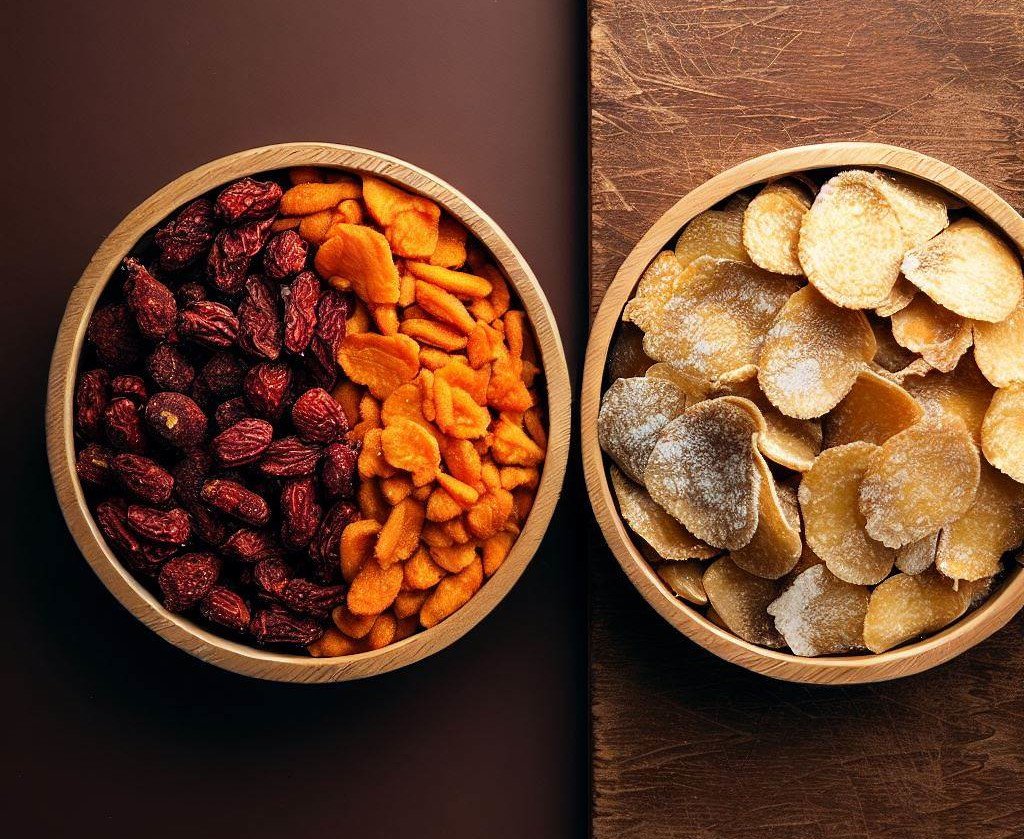When it comes to long-term food preservation, two popular methods often come to mind: freeze drying and dehydration. Freeze dried and dehydrated foods offer extended shelf life, easy storage, and convenient consumption options for outdoor enthusiasts, emergency preparedness, and even everyday use. In this article, we will delve into the differences between these two methods, exploring their impact on shelf life, nutrient retention, and the requirements for each process.
Shelf Life:
One of the key considerations for food preservation is the shelf life of the final product. Both freeze drying and dehydration significantly extend the lifespan of food items, but there are slight differences between them.
Freeze Drying:
Freeze drying involves removing water from food items by freezing them and then subjecting them to a vacuum to evaporate the ice crystals. This process preserves the food’s cellular structure, taste, and nutrients. The resulting freeze-dried food can have an impressively long shelf life, often ranging from 25 to 30 years when stored properly in sealed containers. This extended shelf life is due to the extremely low moisture content, which inhibits microbial growth and enzymatic reactions.
Dehydration:
Dehydration, on the other hand, removes moisture from food items through the application of heat. This process involves circulating warm air or using a specialized dehydrator to evaporate the water content. While dehydration effectively extends the shelf life of foods, it is typically shorter compared to freeze-dried foods. Dehydrated foods can last anywhere from several months to a few years, depending on the storage conditions and the specific type of food. Proper packaging and storage are crucial to prevent moisture absorption, which can reduce shelf life.
Nutrient Retention:
Preserving the nutritional value of food during the preservation process is a significant concern for many individuals. Both freeze drying and dehydration impact the nutrient content of foods, but to different extents.
Freeze Drying:
Freeze drying is widely regarded as one of the best methods for retaining the nutritional integrity of food items. The low-temperature process minimizes damage to vitamins, minerals, and other essential nutrients. Freeze-dried foods often maintain a majority of their original nutritional value, including vitamins, proteins, and enzymes. However, some loss of heat-sensitive nutrients like vitamin C may occur during the process.
Dehydration:
Dehydration involves the application of heat, which can cause some nutrient loss. Vitamins such as vitamin C and thiamine are particularly vulnerable to degradation when exposed to high temperatures. Nevertheless, dehydration still preserves a significant portion of the food’s nutritional value, including minerals, fiber, and antioxidants. It is important to note that the nutrient content may vary depending on the specific food item and the dehydration process employed.
Requirements for Freeze Drying and Dehydration:
Both freeze drying and dehydration require specific equipment and processes.
Freeze Drying:
Freeze drying is a more complex and expensive process compared to dehydration. It typically requires specialized equipment known as a freeze dryer or lyophilizer. These machines utilize a combination of freezing and vacuum systems to remove moisture from food. Additionally, freeze drying may necessitate pre-treatment of certain foods to maintain their quality, such as blanching vegetables or pre-freezing fruits.
Dehydration:
Dehydration is a relatively simpler and more accessible method. To dehydrate food, you can use a dehydrator, an oven set to a low temperature, or even the sun. Dehydrators provide precise temperature and airflow control for consistent results. It is essential to cut food items into uniform slices or pieces to ensure even drying. Dehydrated foods can also be prepared using traditional methods like air drying or sun drying, but these methods may be less effective in terms of consistency and time required.
Conclusion:
Freeze drying and dehydration are two popular methods of food preservation, each with its advantages and considerations. While freeze-dried foods tend to have a longer shelf life and superior nutrient retention, the freeze-drying process requires specialized equipment and can be more expensive. On the other hand, dehydration is a more accessible method that can be achieved with basic equipment like a dehydrator or an oven.
When deciding between freeze-dried and dehydrated foods, it’s important to consider your specific needs and priorities. If long-term storage and maximum nutrient retention are crucial factors, freeze-dried foods may be the preferred option. However, if you’re looking for a simpler and more affordable method with still relatively long shelf life and acceptable nutrient preservation, dehydration can be a suitable choice.
Regardless of the preservation method you choose, proper packaging and storage conditions are vital to ensure the longevity and quality of the preserved foods. It is essential to store both freeze-dried and dehydrated foods in airtight containers, away from moisture, heat, and light.
Lastly, keep in mind that while freeze-dried and dehydrated foods offer convenience and extended shelf life, they should not replace a varied and balanced diet consisting of fresh, whole foods. These preserved options can serve as a valuable addition to your pantry, especially during emergencies or outdoor adventures, but should be complemented with fresh ingredients whenever possible.
In conclusion, freeze drying and dehydration are effective methods for preserving food with extended shelf life and nutrient retention. Understanding the differences between the two processes and considering your specific needs will help you make an informed decision when it comes to selecting the right method for preserving your food. Whether you opt for freeze-dried or dehydrated foods, enjoy the convenience and peace of mind that comes with having long-lasting food options readily available.

Comments